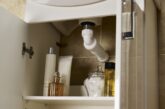
It’s crucial that thermostatic mixing valves (TMVs) are installed in the property to keep homes safe and comply with the Building Regulations, explains Richard Bateman, Product Manager for Plumbing and Heating at RWC.
Last year, the Chartered Institute of Plumbing & Heating Engineering (CIPHE) raised awareness around a worrying rise in the number of incidents with scalding and burn injuries. The trade body found that from 2017-2018, people who were treated in hospitals for scalding from taps jumped up from 713 to 755 (nearly 6 per cent), on those admitted the previous year. However, hot water incidents can easily be minimised, so long as thermostatic mixing valves (TMVs) are installed and used in the right way.
Why are TMVs so important?
TMVs are crucial because they allow hot water to circulate at a high temperature to prevent Legionella bacteria from breeding in the system, while ensuring safe water temperature from outlet to prevent scalding injuries.
The key to avoiding Legionnaires’ disease is to kill the bacteria in water supplies themselves. Water needs to be stored above 60°C in domestic buildings to kill Legionella. However, these temperatures are hot enough to cause scalding.
To resolve these concerns TMVs are installed before water outlets. They allow the hot water system to run at a higher disinfection temperature, which can be blended with cold water at the point of use to achieve a pre-set safe temperature from the outlet. Alongside this, TMVs are also responsible for ensuring a safe outlet temperature even when water pressure fluctuates due to the simultaneous use of other appliances.
Regulation around TMVs
In 2010 it became a legal requirement to install TMVs in all domestic new builds. This is to comply with The Building Regulations 2000, Approved Document G – sanitation, hot water safety and water efficiency. The regulation extends to any properties undergoing a ‘change of use’ after 2012. Further to this law, TMVs are also regulated by the Recommended Code of Practice for Safe Water Temperatures by the Thermostatic Mixing Valve Manufacturers.
Choosing the right TMV
There are several TMVs to choose from – but for domestic applications, you need TMV2 certified valves to comply with the regulations and the TMV2 Scheme (formerly known as the BuildCert scheme). Under this scheme TMVs must always maintain a safe and stable temperature of under 48°C from outlets and quickly shut off in the event of hot or cold-water failure.
At RWC, we have a range of TMV2 certified valves to choose from our Reliance Valves brand, which in addition feature a rapid failsafe mechanism to shut off the valve for stopping the water supply to outlet, in case either hot or cold supplies are cut off/interrupted.
When choosing a TMV, you also need to consider how fast and easy it is to install and service the valve. The quicker and simpler it is to install the TMV, the faster you can move onto the next part of the project.
This is where the Easifit TMV can help. TMV2 certified, this valve is ultra-compact and lightweight and, with its small footprint, it lends itself to tight spaces underneath baths and basins. Its flat faced union connections also make any future maintenance much simpler and more efficient. Designed to run at exceptionally low flow rates, it helps reduce the property’s water consumption as well. The valve is WRAS approved and reduces the risk of scalding, while reducing bacteria growth by enabling hot water systems to run at a higher temperature.
CIPHE further highlighted in their report, that of the 755 finished consultant episodes allocated to scalds from taps between 2017-2018, a staggering 185 were for children aged under-four.
With the correct specification and use of TMVs, compliance can be met, ad your project can run smoothly. Most importantly, potentially fatal injuries can be prevented, and homes can be safeguarded.
For more information on the Easifit TMV from RWC visit www.rwc.co.uk/product/easifit-thermostatic-mixing-valve/







